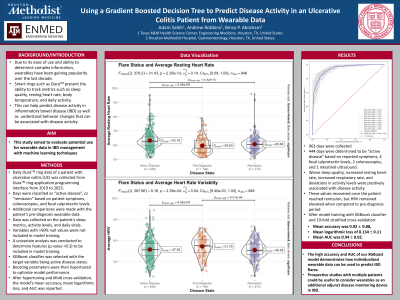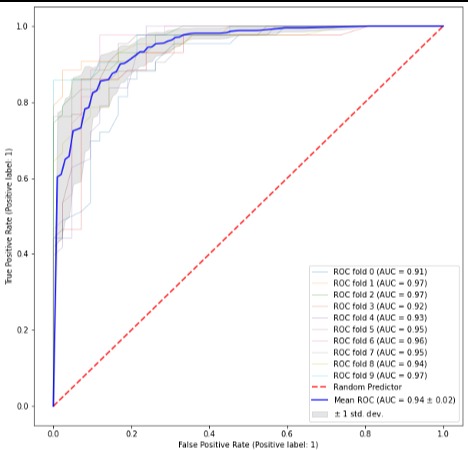Tuesday Poster Session
Category: IBD
P3541 - Using a Gradient Boosted Decision Tree to Predict Disease Activity in Ulcerative Colitis Patient From Wearable Data
Tuesday, October 24, 2023
10:30 AM - 4:00 PM PT
Location: Exhibit Hall

Has Audio
- AS
Adam A. Saleh, BS
Texas A&M College of Engineering Medicine
Houston, TX
Presenting Author(s)
Adam A.. Saleh, BS1, Andrew Robbins, PhD1, Bincy Abraham, MD, MS, FACG2
1Texas A&M College of Engineering Medicine, Houston, TX; 2Houston Methodist-Weill Cornell, Houston, TX
Introduction: Due to its ease of use and ability to determine complex information, wearables have been gaining popularity over the last decade. Smart rings such as OuraTM present the ability to track metrics such as sleep quality, resting heart rate, body temperature, and daily activity. This is not only useful for the predicting disease activity in inflammatory bowel disease (IBD), but also to understand behavior changes that can be associated with disease activity. This study aimed to evaluate potential use for wearable data in IBD management.
Methods: Daily OuraTM ring data of a patient with ulcerative colitis (UC) was collected from OuraTM ring application programming interface from 2019 to 2023. Days were classified as “flare” or “remission” based on patient symptoms, colonoscopies, and fecal calprotectin levels. Data was collected on the patient’s sleep metrics, activity levels, and daily vitals. Variables with >50% null values were not included in model training. A univariate analysis was conducted to determine features that correlated with flaring periods (p-value < 0.3) to be included in model training. An XGBoost classifier was selected with the target variable being flare status. Boosting parameters were then hypertuned to optimize model performance. After hypertuning and kfold cross-validation, the model’s mean accuracy, mean logarithmic loss, and AUC was reported.
Results: 963 days were collected. 444 days were determined to be “flare” based on reported symptoms, 4 fecal calprotectin levels, 2 colonoscopies, and 1 intestinal ultrasound confirming disease activity. Remission was determined by no reported symptoms, 2 normal fecal calprotectin levels and a normal intestinal ultrasound. Generally, worse sleep quality, increased resting heart rate, increased respiratory rate, and deviations in activity levels were positively associated with disease activity. After model training with XGBoost classifier and 10-fold stratified cross-validation, the mean accuracy was 0.92 ± 0.08, mean logarithmic loss of 0.134 ± 0.11, and a mean AUC was 0.94 ± 0.02.
Discussion: Data from the OuraTM ring demonstrated the potential application of wearables in IBD management in a single patient with UC. The high accuracy and AUC of our XGBoost model demonstrates how individualized wearable data can be used to predict IBD flares. Prospective studies with multiple patients could be useful to consider wearables as an additional adjunct disease monitoring device in IBD.

Disclosures:
Adam A.. Saleh, BS1, Andrew Robbins, PhD1, Bincy Abraham, MD, MS, FACG2. P3541 - Using a Gradient Boosted Decision Tree to Predict Disease Activity in Ulcerative Colitis Patient From Wearable Data, ACG 2023 Annual Scientific Meeting Abstracts. Vancouver, BC, Canada: American College of Gastroenterology.
1Texas A&M College of Engineering Medicine, Houston, TX; 2Houston Methodist-Weill Cornell, Houston, TX
Introduction: Due to its ease of use and ability to determine complex information, wearables have been gaining popularity over the last decade. Smart rings such as OuraTM present the ability to track metrics such as sleep quality, resting heart rate, body temperature, and daily activity. This is not only useful for the predicting disease activity in inflammatory bowel disease (IBD), but also to understand behavior changes that can be associated with disease activity. This study aimed to evaluate potential use for wearable data in IBD management.
Methods: Daily OuraTM ring data of a patient with ulcerative colitis (UC) was collected from OuraTM ring application programming interface from 2019 to 2023. Days were classified as “flare” or “remission” based on patient symptoms, colonoscopies, and fecal calprotectin levels. Data was collected on the patient’s sleep metrics, activity levels, and daily vitals. Variables with >50% null values were not included in model training. A univariate analysis was conducted to determine features that correlated with flaring periods (p-value < 0.3) to be included in model training. An XGBoost classifier was selected with the target variable being flare status. Boosting parameters were then hypertuned to optimize model performance. After hypertuning and kfold cross-validation, the model’s mean accuracy, mean logarithmic loss, and AUC was reported.
Results: 963 days were collected. 444 days were determined to be “flare” based on reported symptoms, 4 fecal calprotectin levels, 2 colonoscopies, and 1 intestinal ultrasound confirming disease activity. Remission was determined by no reported symptoms, 2 normal fecal calprotectin levels and a normal intestinal ultrasound. Generally, worse sleep quality, increased resting heart rate, increased respiratory rate, and deviations in activity levels were positively associated with disease activity. After model training with XGBoost classifier and 10-fold stratified cross-validation, the mean accuracy was 0.92 ± 0.08, mean logarithmic loss of 0.134 ± 0.11, and a mean AUC was 0.94 ± 0.02.
Discussion: Data from the OuraTM ring demonstrated the potential application of wearables in IBD management in a single patient with UC. The high accuracy and AUC of our XGBoost model demonstrates how individualized wearable data can be used to predict IBD flares. Prospective studies with multiple patients could be useful to consider wearables as an additional adjunct disease monitoring device in IBD.

Figure: Mean ROC of XGBoost classifier after k-fold cross validation.
Disclosures:
Adam Saleh indicated no relevant financial relationships.
Andrew Robbins indicated no relevant financial relationships.
Bincy Abraham: AbbVie – Consultant, Grant/Research Support, Speakers Bureau. Bristol Myers Squibb – Consultant, Speakers Bureau. Celltrion – Consultant. Eli Lilly – Consultant, Speakers Bureau. Janssen – Consultant, Speakers Bureau. Medtronics – Consultant. Pfizer – Consultant, Speakers Bureau. Samsung Bioepis – Consultant. Takeda – Consultant, Grant/Research Support, Speakers Bureau.
Adam A.. Saleh, BS1, Andrew Robbins, PhD1, Bincy Abraham, MD, MS, FACG2. P3541 - Using a Gradient Boosted Decision Tree to Predict Disease Activity in Ulcerative Colitis Patient From Wearable Data, ACG 2023 Annual Scientific Meeting Abstracts. Vancouver, BC, Canada: American College of Gastroenterology.
